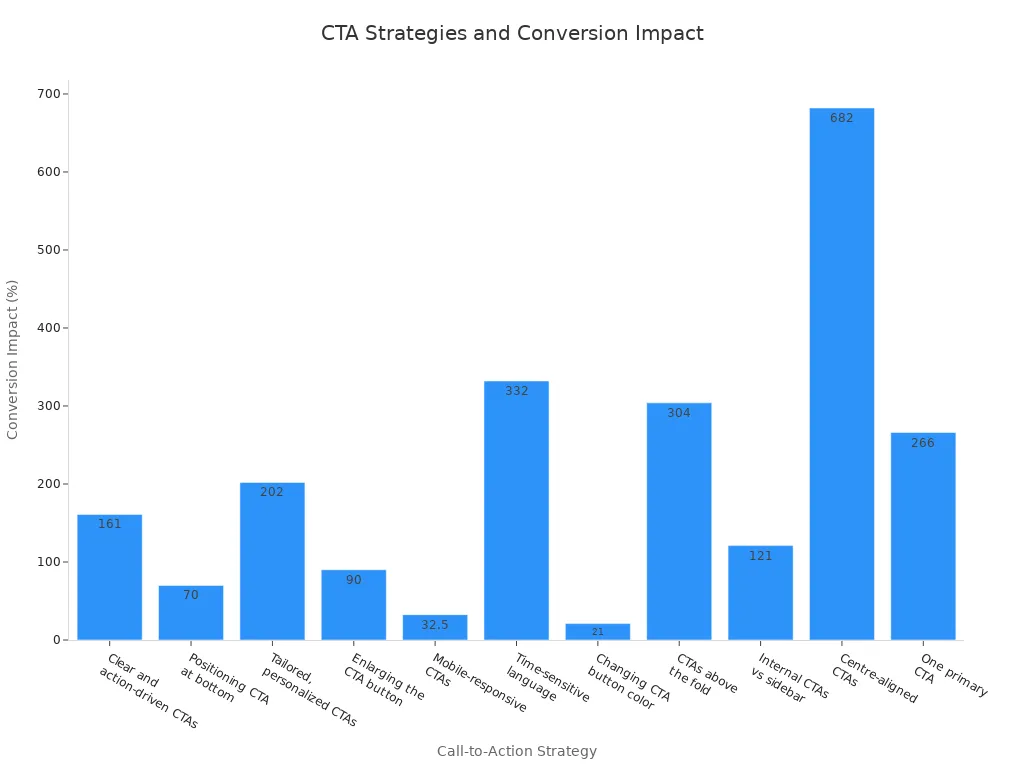AI Copywriting for Ecommerce: Write SEO Descriptions That Rank and Convert

You want your ecommerce products to be noticed and bought. AI Copywriting helps you do better than others. It makes your work faster and lets you write more. It also helps your SEO rankings go up. You get product descriptions that bring in more shoppers. These descriptions help turn visits into sales.
Users often get more sales when descriptions fit what customers want.
Statistic | Impact |
|---|---|
After using AI-powered product descriptions |
AI Copywriting tools find trends fast. They give ideas to make things better. They help you stay ahead in a busy market.
Key Takeaways
AI copywriting tools help you save time. They can also help you sell more by making interesting product descriptions.
Use the right keywords in a natural way. This helps people find your products and brings in good customers.
Talk about the benefits, not just the features. This helps shoppers feel connected to your products.
Make your descriptions short and easy to read. Use bullet points so people can scan them quickly.
Use the same brand voice in every product description. This helps people trust your brand and remember it.
Update your product descriptions often. This keeps them fresh and matches what customers want now.
Add customer reviews to your descriptions. This makes your products seem more trustworthy and helps people decide what to buy.
Try different calls-to-action. See which words make people want to buy the most.
High-Converting Descriptions

You want your product descriptions to do more than just fill space. They need to grab attention, answer questions, and make people want to buy. Let’s break down what makes a description truly convert.
Essential Elements
Keywords
You need the right keywords to help shoppers find your products. Start by thinking about what your customers type into search bars. Use those words in your descriptions, but keep it natural. AI Copywriting tools can help you spot trending keywords and weave them in smoothly. This way, your products show up when people search, and your text still sounds human.
Persuasion
Great descriptions do more than list features. They show how your product helps the customer. Imagine you’re talking to a friend. Tell them how your product solves a problem or makes life better. Use words that paint a picture. For example, instead of saying “soft blanket,” try “wrap yourself in warmth after a long day.” AI Copywriting can suggest phrases that spark emotion and make your product stand out.
Tip: Focus on benefits, not just features. Help your customer picture themselves using your product.
Clarity
Keep your language simple and direct. Avoid long sentences and confusing words. Make sure every sentence adds value. If your customer can understand your description quickly, they’re more likely to buy. Use bullet points for key details. This makes your text easy to scan.
Relevance
Write for your ideal customer. Think about what matters most to them. If you sell trainers, mention comfort, style, and durability. Show what others think by adding a short review or rating. This builds trust and helps shoppers make decisions faster.
Focus on how your product helps, not just what it does
Use words that create a vivid image
Tailor your message to your ideal customer
Show customer reviews to build trust
Make your text easy to read
User Experience
A good description does more than use the right words. It also looks good and feels easy to use. Make sure your product page is clear and inviting. Use high-quality images and detailed specs. Add sizing info and reviews where shoppers can see them. Simple navigation and clear call-to-action buttons help people move from reading to buying.
An intuitive and visually appealing layout keeps shoppers interested
Clear navigation and strong call-to-action buttons boost engagement
High-quality images and detailed specs help customers make choices
Brand Voice
Your brand voice sets you apart. Keep it consistent in every description. If your brand is playful, use fun language. If it’s serious, keep your tone professional. A strong voice makes your brand memorable and helps shoppers feel connected.
Evidence | Description |
|---|---|
A clear brand voice helps people remember you in a crowded market. | |
Emotional Connections | An authentic voice builds emotional ties with your customers. |
Brand Loyalty | A strong voice encourages repeat purchases and turns buyers into fans. |
When you use AI Copywriting, you can keep your brand voice steady across hundreds of products. This builds trust and keeps customers coming back.
AI Copywriting Tools

How They Work
You want to save time and boost your sales. AI copywriting tools help you do both. These tools use smart technology to write product descriptions for you. You give them a few details about your product. They create descriptions that sound natural and fit your brand. Some tools, like AdZis and Copysmith, can write hundreds of descriptions in minutes. Shopify Magic works right inside your store, so you do not need to switch between apps. Jasper and Copy.ai let you choose the style and length you want. Anyword and Copymatic focus on making your copy convert more shoppers. Talkoot helps you keep your brand voice steady across all your products. Hypotenuse AI stands out because it creates content that is ready to convert and can scale for big shops with its API.
These tools do more than just inform. They persuade shoppers and help them feel connected to your products.
You can use them to create descriptions that turn browsers into buyers by showing how your product meets their needs.
Tip: You do not need to be a writer to get great results. AI copywriting tools handle the hard work for you.
Prompts and Keywords
You get the best results when you give clear instructions. Tell the tool what your product is, who it is for, and what makes it special. Use keywords that shoppers type when searching for products like yours. This helps your descriptions show up in search results and reach more people.
Best Practice | Description |
|---|---|
Use detailed prompts to guide AI in generating relevant content. | |
SEO Integration | Add keywords and structure for better visibility. |
Emotional Resonance | Write copy that connects with your audience. |
When you use detailed prompts and the right keywords, your descriptions become more relevant and engaging. You help shoppers find your products and feel excited to buy.
Tone and Style
Your brand voice matters. You want every description to sound like you. AI copywriting tools let you pick the tone that fits your shop. You can choose playful, serious, or anything in between. Tools like Talkoot and Jasper help you keep your voice steady, even if you have hundreds of products. This builds trust and makes your shop feel professional.
Key Points | Description |
|---|---|
AI helps you sound the same everywhere, which builds trust. | |
Choosing the Right AI Tool | Pick a tool that matches your brand’s voice and style. |
When you use the right tool, you keep your brand strong and your customers coming back. AI copywriting gives you the power to scale your shop and stay ahead in a busy market.
SEO with AI Copywriting

You want your product descriptions to show up in search results and attract the right shoppers. With the right steps, you can use AI Copywriting tools to make your descriptions both search-friendly and unique. Let’s walk through the process together.
Keyword Research
You need to know what your customers are searching for before you start writing. AI tools like GetGenie and SECockpit help you find the best keywords for your products. These tools do more than just list popular words. They show you what your competitors miss and help you spot gaps in your content. You can use them to understand what your shoppers want and plan your content around those needs.
Get keyword suggestions and spot gaps in your current content.
Choose tools that fit your shop’s size and your workflow.
Use keyword research to learn about your customers’ intent, not just the words they type.
Tip: Focus on keywords that match what your shoppers are really looking for. This helps you write descriptions that answer their questions and solve their problems.
Crafting Prompts
When you use AI Copywriting tools, you need to give clear instructions. This is where prompt crafting comes in. The better your prompt, the better your product description.
Be specific. Tell the tool exactly what you want, including word count and target keywords.
Outline the structure. Ask for headings, bullet points, or sections if you need them.
Define your audience. Let the tool know who will read the description.
Give examples. Share a sample of your favourite product description.
Review and refine. Try different prompts and see what works best.
Mix AI and human writing. Sometimes, you get the best results by combining both.
Prompt engineering lets you create detailed content that targets long-tail keywords. You can ask the AI to write guides or answer common questions. This helps you reach shoppers who use specific search terms. When you personalise your prompts, your descriptions feel more engaging and keep shoppers on your page longer.
Editing Output
Once you have your AI-generated descriptions, you need to make sure they stand out and follow SEO rules. Editing is where you add the final polish.
Uniqueness
You want every product description to be one of a kind. Start by checking that your text does not copy other sites. Use your brand’s voice and add details that only your shop can offer. This helps your products stand out and builds trust with your customers.
Check for duplicate content using online tools.
Add your own touch with unique product features or customer reviews.
Keep your brand voice steady across all descriptions.
SEO Compliance
Your descriptions need to follow SEO best practices. Use your main keywords naturally. Do not force them into every sentence. Make sure your text is easy to read and answers common customer questions.
Use keywords where they fit, like in headings or bullet points.
Keep sentences short and clear.
Add important details, such as size, colour, or material.
Make sure your descriptions match what shoppers see in your images.
Note: Good SEO is about helping shoppers find what they need, not just pleasing search engines.
Here’s a simple step-by-step guide to using AI Copywriting tools for SEO-optimised product descriptions:
Identify the sections you need for your product descriptions. Think about what your customers want to know.
Get your API key if you use a tool like Screaming Frog with OpenAI.
Enable HTML storage in your tool’s settings.
Connect your API key to the tool.
Set up your prompt for the AI to generate descriptions.
Filter your crawl to focus on category pages, so you only create relevant content.
By following these steps, you make sure your product descriptions are both unique and SEO-friendly. You help your shop rank higher and attract more buyers.
Publishing
You have written your product descriptions with AI. Now, you want to make sure they reach your customers and help your shop rank higher. Publishing is more than just pressing a button. You need a plan to get the most out of your new content.
Here’s a simple step-by-step guide to help you publish AI-generated product descriptions for maximum SEO impact:
Upload Descriptions to Your Store
Add your new descriptions to each product page. Make sure you replace old or outdated text. Check that your formatting looks clean and matches the rest of your site.Review and Update Regularly
Don’t just set and forget. Go back every few months and read your descriptions. Update them to match new trends or changes in your products. This keeps your shop fresh and helps you stay ahead in search rankings.Optimise for Voice Search
People use voice assistants to shop online. Make your descriptions sound natural and conversational. Use simple phrases and questions that people might say out loud. This helps your products show up when shoppers use voice search.A/B Test Your Descriptions
Try different versions of your product descriptions. See which ones get more clicks or sales. Use tools to track performance. Change your text based on what works best. This helps you find the words that turn visitors into buyers.Use Brand-Specific Language
Keep your brand voice strong. Use words and phrases that fit your shop’s personality. This makes your store stand out and helps customers remember you.
Tip: Set a reminder to review your product descriptions every quarter. Small updates can make a big difference in your SEO and sales.
Publishing Step | Why It Matters |
|---|---|
Regular Updates | Keeps your content relevant and boosts rankings |
Voice Search Optimisation | Reaches shoppers using smart speakers and phones |
A/B Testing | Finds the best copy for conversions |
Brand Language | Builds trust and loyalty with your audience |
You can use these steps to make sure your AI-generated descriptions work hard for your shop. When you publish with care, you help your products get noticed and bought.
Best Practices

Structure
You want your product pages to be easy to use. Good structure helps shoppers find things quickly. Start with a headline that uses your main keyword. Add a short summary about the best feature. Use bullet points for details like size, colour, and material. Put customer reviews where people can see them. Show shipping info and stock status at the top. Link to other products so visitors can look at more items.
Here’s what SEO experts say about product descriptions:
Structural Element | Description |
|---|---|
Unique, keyword-rich product descriptions | Stops copying and helps your shop show up in searches. |
Structured data markup | Makes your products stand out in search results. |
Optimised image alt tags | Helps your pictures get found by search engines. |
Customer reviews | Adds new content and builds trust with shoppers. |
Clear shipping details and stock status | Gives shoppers and search engines important info. |
Internal linking to related products | Makes it easier to move around your shop and helps SEO. |
Schema markup for prices and reviews | Shows product details in search results. |
A strong structure helps shoppers find things fast. You keep them on your page longer and help them buy.
Length
You might wonder how much you should write. If you write too little, shoppers miss key info. If you write too much, they get bored. The best length for product descriptions is between 305 and 400 words. This lets you share all the main features and benefits. It does not overwhelm your reader.
Write 305–400 words for each product.
Focus on what the product does, who it’s for, and why it’s special.
Use short paragraphs and bullet points to make reading easy.
Tip: Keeping your descriptions this length helps your shop show up in searches and get more sales.
Calls-to-Action
You want shoppers to do something, not just look. A strong call-to-action (CTA) helps a lot. Use clear phrases like “Buy Now”, “See More”, or “Add to Basket”. Put your CTA where it is easy to see—at the top or bottom of the page. Make the button big and simple to tap, especially on phones. Try using words like “Limited Stock—Order Today!” to make shoppers act fast.
Here’s how different CTA ideas change conversions:
Call-to-Action Strategy | Conversion Impact |
|---|---|
Clear and action-driven CTAs | Can boost conversions by up to 161% |
Positioning CTA at the bottom | Can increase conversions by 70% |
Tailored, personalised CTAs | Work better than generic ones by 202% |
Enlarging the CTA button | 90% more people click through |
Mobile-responsive CTAs | 32.5% more conversions on phones |
Time-sensitive language | Can raise conversion rates by 332% |
Changing CTA button colour | 21% more conversions |
CTAs above the fold | 304% more clicks |
Internal CTAs vs sidebar CTAs | 121% higher click-through rate |
Centre-aligned CTAs | 682% more clicks |
One primary CTA | 266% more conversions |

You can try different CTA texts to see what works best. Customising your CTA helps you connect with shoppers and makes them want to buy.
Avoiding Duplicates
Duplicate content can quietly hurt your shop’s rankings and confuse your customers. You want every product page to stand out, not fight for attention with similar pages. When you use unique descriptions, you help shoppers find what they need and make your site easier for search engines to understand.
Unique content gives your products a better chance to shine in search results. It also stops your pages from competing against each other for the same keywords.
You might wonder how duplicate content sneaks in. It often happens when you copy manufacturer descriptions or use the same text for similar products. Sometimes, small changes in your URLs or product options can create extra pages with the same content. Search engines get confused and may not know which page to show.
You can take simple steps to avoid this problem:
Write a fresh description for each product. Even small changes help.
Use redirects to guide visitors and search engines to the right page.
Fix URL inconsistencies so each product has one clear address.
Make sure every meta tag is unique and matches the page.
Add customer reviews to bring in new, original content.
Use structured data to help search engines understand your products.
Let’s break it down into a step-by-step process:
Spot duplicate content using tools like SEMrush or Screaming Frog.
Check your site with a content audit to see where duplication happens.
Write unique product descriptions for every page.
Add canonical tags to show search engines your preferred page.
Set up 301 redirects to combine duplicate pages.
Make sure all meta tags are different and clearly labelled.
Use structured data for better indexing.
Encourage customers to leave reviews for more unique content.
Look at your URLs and fix any that create extra pages.
Keep an eye on Google Search Console for duplicate warnings.
You do not need to fix everything at once. Start with your best-selling products and work your way through the rest. Over time, you will see better rankings and happier shoppers.
Monitoring
You want to know if your new product descriptions are working. Monitoring helps you see what’s going well and what needs a tweak. AI tools make this job easier by tracking how shoppers interact with your pages.
Method | Description |
|---|---|
Understanding User Behaviour | AI looks at what shoppers do on your site and finds out which descriptions lead to sales. |
Adaptive Content Generation | AI changes your content based on what works best for your audience. |
Feedback Loop | AI learns from your results and keeps improving your descriptions over time. |
Engagement Metrics | AI checks things like bounce rate and time on page to see if people like your content. |
You can use these insights to make smart changes. For example, if you see that shoppers spend more time on certain pages, you know those descriptions work well. If a page has a high bounce rate, you might need to rewrite the text or add more details.
Tip: Check your product pages every month. Look for patterns in your sales and engagement. Small updates can lead to big improvements in your rankings and conversions.
By keeping an eye on your content, you make sure your shop stays fresh and competitive. You also learn what your customers love, so you can give them more of it.
Common Pitfalls

Over-Optimisation
You might think more keywords help your shop rank higher. But using too many keywords can actually hurt your site. Search engines notice when you use too many keywords. They might lower your page ranking. This makes it harder for shoppers to find your products. Too many keywords also make your text hard to read. Shoppers may leave your site if the writing feels strange.
Pet Flaps UK got 466% more sales after they stopped using too many keywords. Ultimate Gaming Paradise made 3451% more money by using better SEO. When you write in a natural way, shoppers stay on your page longer. Using too many keywords makes people leave your site quickly. If search engines punish your site, it can take months to fix. You might lose sales while you wait.
Tip: Only use keywords where they make sense. Write for people first, not just for search engines.
Generic Copy
AI can write quickly, but sometimes the text is boring. You want your products to be special, not sound like every other shop. Phrases like “Our cutting-edge solution provides value to customers…” are dull. Shoppers want to feel a real connection and trust your brand.
Some people think AI can do everything alone. But you still need to add your own ideas. If you only use boring text, shoppers will not trust you. Adding customer names or showing how many items are left can make people want to buy. Showing likes or reviews helps shoppers feel sure about your shop.
Evidence Type | Description |
|---|---|
Customer Engagement | Good writing builds trust and helps you sell more. |
Persuasion Techniques | Using words like “you” makes people feel something. |
Visual Content | Videos and clear photos help shoppers trust your shop. |
Block Quote:
"AI often writes things like: 'Our cutting-edge solution provides value to customers…' Boring. This kind of writing makes people trust you less."
Brand Voice Loss
Your brand voice makes your shop different from others. If you let AI write everything, you might lose your special style. AI does not understand feelings or your shop’s story. It can make your writing sound cold or even unfair. Shoppers notice when your text feels strange. They might leave and shop somewhere else.
If people do not check the AI’s work, your shop’s values might not show. Too much automation can make your shop seem unfriendly. If the AI’s writing does not match your style, your shop could look bad. Customers want to feel a real link to your shop, not just read plain text.
Check your AI-written content often.
Change the writing so it sounds like your shop.
Make sure your values and style are in every product page.
Note: Your brand voice helps people remember you. Keep it strong by mixing AI with your own ideas.
Ignoring Intent
You might think adding lots of keywords will help your products get found. But if you ignore what your customers really want, your descriptions will miss the mark. Search intent is all about understanding why someone is searching for a product. Are they looking to buy, compare, or just learn more? If you don’t match your descriptions to what shoppers want, you could get lots of visitors but very few sales.
Ignoring keyword research can lead to targeting irrelevant terms, resulting in high traffic but low sales.
Understanding how customers search for products is crucial; otherwise, visibility in search results diminishes.
Let’s say you sell trainers. If you use keywords like “best running shoes for kids” but your product is for adults, you’ll attract the wrong crowd. People will visit your page but leave quickly. This hurts your rankings and wastes your effort.
Tip: Always ask yourself, “What is my customer really looking for?” Write your descriptions to answer their questions and solve their problems.
You can avoid this pitfall by doing a bit of research. Look at the words your customers use. Check what questions they ask. Use those words in your product descriptions. This way, you attract the right people and help them find what they need.
Here’s a quick checklist to help you stay on track:
Use keywords that match your product and your customer’s needs.
Write descriptions that answer common questions.
Make sure your product pages match what people expect to see.
When you focus on intent, you get visitors who are ready to buy. Your shop becomes more helpful, and your sales go up.
Outdated Content
You might not notice when your product descriptions get old. But your customers do. Outdated content can make your shop look neglected. People want to see fresh, accurate information. If your descriptions mention features you no longer offer or show old prices, shoppers may lose trust.
Keeping your ecommerce site updated is not just about looks. It builds trust and helps you get more sales. An active and relevant website is crucial for both customer perception and search engine optimisation. When you update your product descriptions, you show shoppers that you care about their experience.
74% of companies invested in SEO last year, showing how important it is to keep your product descriptions current if you want to maximise sales opportunities.
You can avoid this pitfall by setting a regular schedule to review your product pages. Check for old details, broken links, or missing information. Update your descriptions to match what you actually sell. Add new reviews or photos to keep things fresh.
Note: A shop that feels alive and up-to-date makes shoppers feel confident. They know they can trust you to deliver what you promise.
Stay on top of your content, and you’ll see better rankings, more trust, and higher sales.
Results and Examples

Before and After
You might wonder what changes when you switch to AI copywriting for your ecommerce shop. Let’s look at a typical product description before and after using an AI tool.
Before:
You write a short, plain description. It says, “Blue cotton T-shirt. Comfortable and stylish. Available in sizes S to XL.” This text gives basic facts, but it does not make your product stand out.
After:
You use an AI tool like Hypotenuse AI. The new description says, “Step out in comfort with our blue cotton T-shirt. Soft fabric keeps you cool all day. Choose your perfect fit from sizes S to XL. Loved by shoppers for its classic style and lasting quality.” Now, your product sounds inviting. You show benefits and create a picture in the shopper’s mind.
Tip: AI copywriting helps you turn dull facts into stories that sell.
Ranking Gains
When you use AI tools, you see your products climb higher in search results. AI copywriting tools like Shopify’s built-in features help you add the right keywords and structure. Your product pages become more visible to shoppers searching online.
Here’s a quick look at how two popular AI tools help you:
AI Tool | Key Benefits | Ideal For |
|---|---|---|
Hypotenuse AI | - AI fine-tuned for eCommerce writing. | eCommerce businesses scaling product listings. |
- Generates content optimised for conversions. | ||
- API integration for scalability. | ||
Shopify's AI Tools | - Generates SEO-optimised product pages and ads. | Entrepreneurs seeking quick solutions. |
- Intuitive and beginner-friendly. |
You add keywords that match what shoppers type. Your product pages load faster and look better. You see your shop move up in Google rankings. More people visit your site because they find you easily.
Conversion Boosts
AI copywriting does more than improve your rankings. You also get more sales. When your descriptions speak to the shopper, they feel confident and ready to buy. You show benefits, answer questions, and use a friendly tone.
Shops using Hypotenuse AI report higher conversion rates. They see more shoppers add items to their baskets. Shopify’s AI tools help new sellers write better descriptions quickly. You spend less time writing and more time selling.
You see more clicks on your product pages.
Shoppers stay longer and read more.
Your sales numbers go up.
Block Quote:
“After switching to AI copywriting, our conversion rate jumped by 12%. Shoppers said our product pages felt more helpful and easy to read.”
You can see real changes in your shop. Better descriptions bring more visitors and turn them into buyers. AI copywriting gives you the edge you need to grow your ecommerce business.
Success Stories
You might wonder if AI copywriting really works for ecommerce shops like yours. Let’s look at some real success stories from businesses that decided to give AI a try. These examples show how you can boost your rankings, get more sales, and save time.
1. The Jewellery Boutique
A small online jewellery shop wanted to stand out in a crowded market. You know how hard it is to write hundreds of unique product descriptions. The owner used Copysmith to generate fresh, SEO-friendly copy for every item. Within three months, the shop saw a 28% jump in organic traffic. Customers spent more time browsing, and the conversion rate went up by 15%. The owner said,
“AI helped me focus on my customers, not just my products. I finally had time to grow my business.”
2. The Eco-Friendly Home Store
You care about your brand’s message. This shop sells sustainable home goods and wanted every product page to reflect its values. The team used Talkoot to keep their brand voice consistent. They also added customer reviews and benefits to each description. After updating 200 product pages, the shop’s bounce rate dropped by 22%. Repeat purchases increased by 18%.
Tip: Use AI to keep your brand voice strong. Your customers will notice the difference.
3. The Sportswear Retailer
A sportswear shop struggled with low search rankings. You know how important it is to get noticed online. The team used Jasper to research keywords and write descriptions that matched what shoppers searched for. They also tested different calls-to-action. After six weeks, their top products ranked on the first page of Google. Sales for those items rose by 31%.
Note: AI can help you find the right words and get your products in front of more people.
Quick Results Table
| Shop Name | AI Tool Used --- | Key Outcome --- | SEO/Conversion Gain --- | | The Jewellery Boutique | Copysmith --- | Unique descriptions --- | +28% traffic, +15% conversions --- | | Eco-Friendly Home Store | Talkoot --- | Consistent brand voice --- | -22% bounce rate, +18% repeat sales --- | | Sportswear Retailer | Jasper --- | Keyword targeting --- | First-page ranking, +31% sales --- |
You can see how these shops used AI to solve real problems. They saved time, improved their rankings, and made more sales. If you want results like these, try an AI copywriting tool for your own shop. You might be surprised by how quickly you see changes.
You now know how to use AI copywriting for product descriptions that rank and sell. Start by picking the right tool, add your keywords, and keep your brand voice strong. Update your pages often. Watch your rankings and sales grow.
Ready to boost your shop? Try an AI tool today and see the results for yourself. Your ecommerce growth starts now! 🚀
FAQ
What is AI copywriting for ecommerce?
AI copywriting uses smart tools to write product descriptions for your online shop. You give the tool some details, and it creates text that helps your products rank higher and sell more.
Can AI copywriting improve my SEO?
Yes, it can. AI tools find the best keywords and use them naturally in your descriptions. You get content that search engines like, so your products show up more often.
Will AI-generated descriptions sound robotic?
Not if you check them. You can edit the text to match your brand’s voice. Most tools let you pick a tone, so your descriptions feel friendly and real.
How do I keep my brand voice with AI tools?
You set the tone and style before you start. Many tools let you save your preferences. Always review the output to make sure it sounds like you.
Do I need to know SEO to use these tools?
No, you don’t. AI copywriting tools guide you through the process. They suggest keywords and structure. You just follow the prompts and check the results.
How often should I update my product descriptions?
You should review your descriptions every few months. Update them when you add new features or spot changes in trends. Fresh content keeps your shop looking active.
Are AI copywriting tools expensive?
You can find free and paid options. Some tools offer free trials. Paid plans usually give you more features and better support. Pick what fits your budget and needs.
Can I use AI copywriting for all my products?
Yes, you can. AI tools help you write for one product or hundreds. They save you time and keep your descriptions consistent across your whole shop.

TangBuy: A Smarter Way to Dropship in 2025
If you're looking to stay competitive with dropshipping in 2025, speed and trend-awareness are key. TangBuy helps you stay ahead with real-time product trends, fast fulfilment, and factory-direct sourcing. With over 1 million ready-to-ship items, 24-hour order processing, and seamless Shopify integration, TangBuy makes it easier to test, scale, and succeed in today's fast-moving eCommerce landscape.
See Also
A Comprehensive Approach to Profitable eBay Selling in 2025
The Ultimate Resource for eBay Profitability in 2025
Essential Strategies for Successful eBay Dropshipping in 2025

